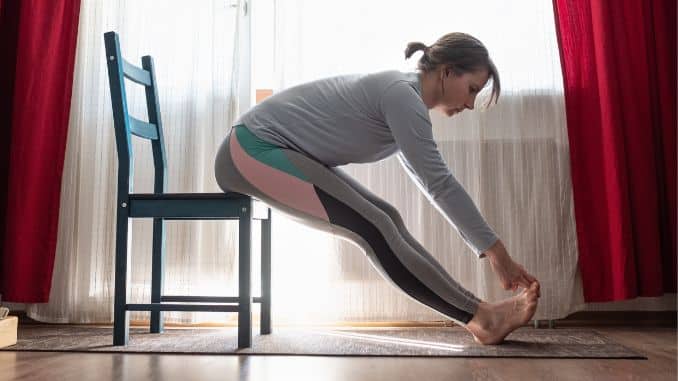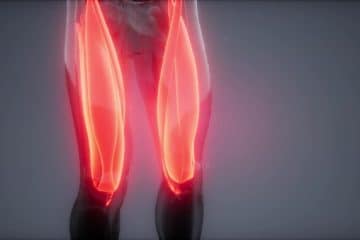Many of us occasionally experience tight thigh muscles, which can be uncomfortable and hinder our daily activities. This article will show useful ways to loosen tight thigh muscles and strengthen your thighs to improve mobility and reduce discomfort. It will guide you through various exercises designed to target the thighs, providing step-by-step instructions so you can perform them safely and effectively.
Benefits Of Strong And Lose Thigh Muscles
Strong thigh muscles offer a range of wonderful benefits. They provide essential support to your knees and hips, minimizing the chance of injuries and enhancing your overall flexibility and mobility. Having well-toned thigh muscles can boost your metabolism, which can help you manage your weight and maintain a healthy body composition more easily. Lastly, strong thighs improve your self-confidence, and posture and increase circulation, enabling you to approach daily activities with greater ease and assurance.
What Causes Tight Thigh Muscles?
Almost all areas of our body muscles are susceptible to overwork or injury. No matter how often, your muscles tighten during the day due to over-exertion. Why do thigh and leg muscles tighten? Let's examine each factor and find the factors that can help.
How to Loosen Tight Thigh Muscles or Tight muscles in the thighs are a common complaint, especially among active people or those with certain jobs.
Many things can cause tight thigh muscles, including:
-
Overuse
This is the most common cause of tight thigh muscles. It can happen if you start a new exercise routine, increase the intensity or duration of your workouts, or do too much activity without giving your muscles time to recover.
-
Dehydration
When dehydrated, your muscles don't function well and are more likely to become tight.
-
Lack Of Movement
Remaining seated or stationary, without any movement, can lead to the tightening of your thigh muscles.
-
Tightness In Other Areas Of The Body
If your hamstrings, glutes, or hips are tight, it can pull on your thigh muscles and make them tight.
-
Injury
An injury to your thigh muscles, such as a strain or tear, can also cause them to become tight.
Thigh Stretches And Strengthening Exercises
1. Wide-Legged Forward Fold Twist
This exercise helps you How to Loosen Tight Thigh Muscles.
Begin in an upright sitting position on the chair with your feet wider than shoulder-width apart, maintaining good alignment in your upper body. Place your hands on the insides of your knees and hinge through your hips to bend your upper body forward. Engage your core and twist your upper body to the right, dipping your left shoulder towards the floor as you press your hands against your knees to widen your legs. Hold the position for a couple of deep belly breaths, in through your nose and out through your mouth. Return to the starting position and repeat the movement on the opposite side.
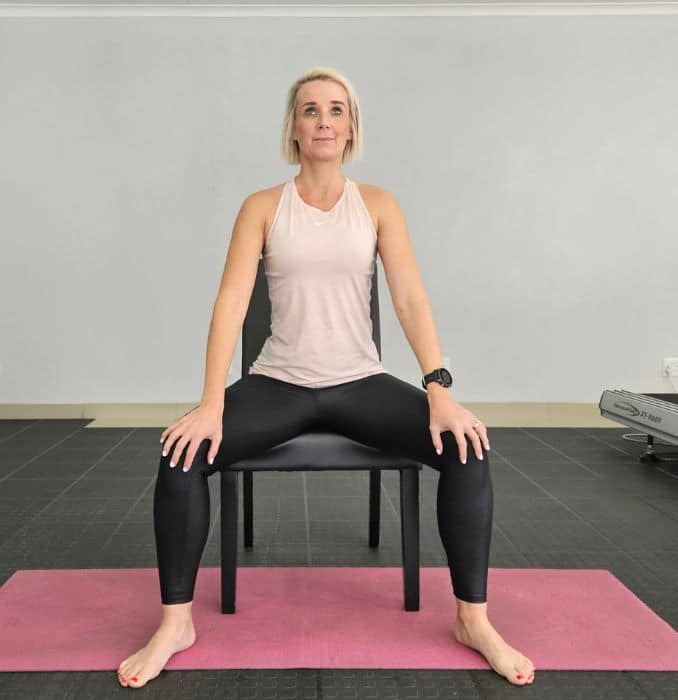 |
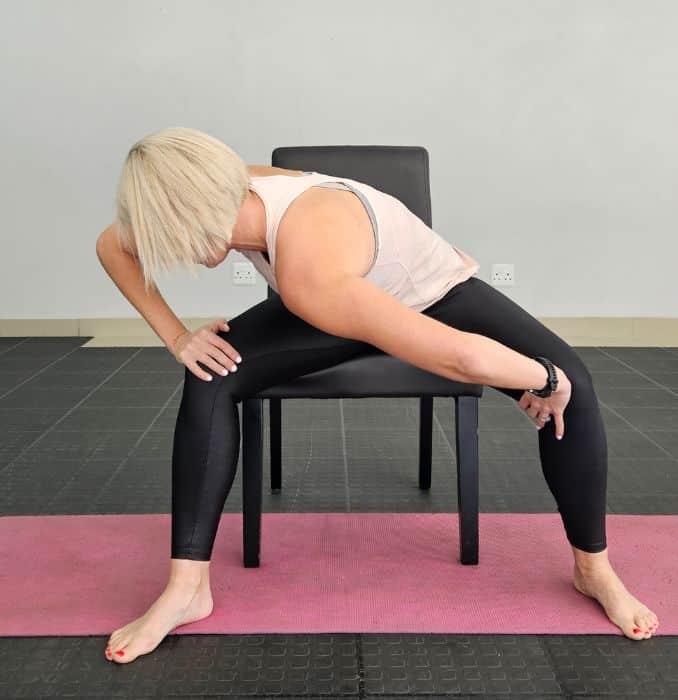 |
Wide-Legged Forward Fold Twist
2. Wide Legged Heel Raises
From the Wide Legged Forward Fold Twist position, slightly hinge through your hips to bend your upper body forward. Then, engage your calf muscles and raise your toes on one foot. Lower your heel back down to return to the starting position and repeat the movement on the opposite side. Start with 1 set of 10 repetitions on each side.
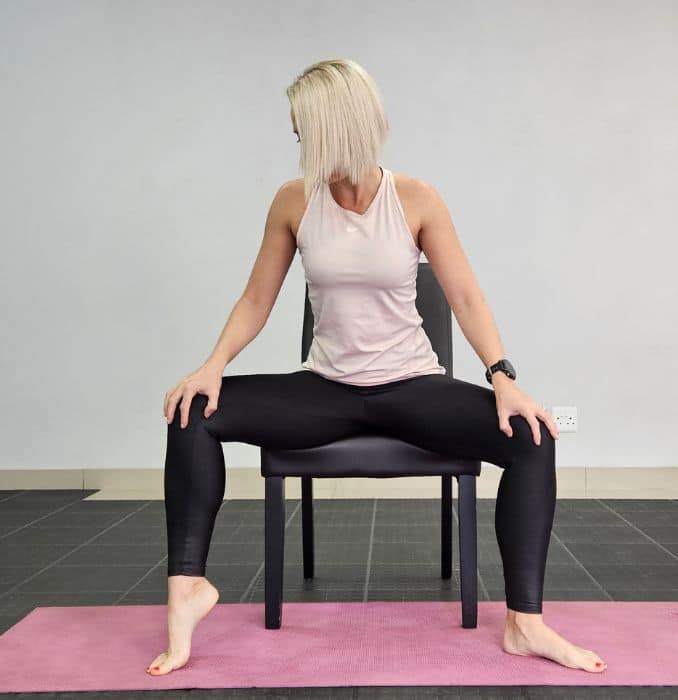 |
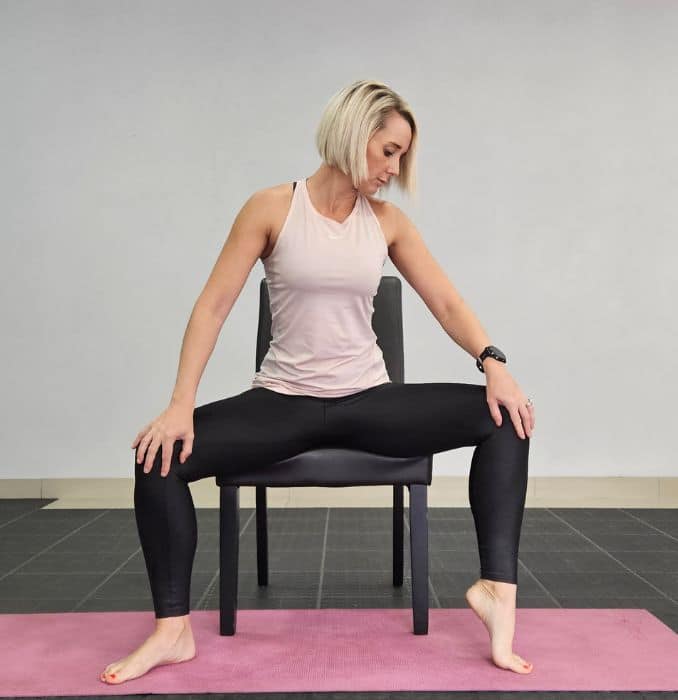 |
Wide-Legged Heel Raises
3. Single Knee To Chest
Firstly, begin in an upright sitting position on the chair with your knees bent and feet flat on the floor, maintaining good alignment with your head, shoulders, and hips. Secondly, engage your core. Then, bring one knee up towards your chest and hold onto your knee with both hands, looking for a light stretch in the hips and lower back. Lastly, lower your leg to return to the starting position and repeat the movement on the opposite side.
 |
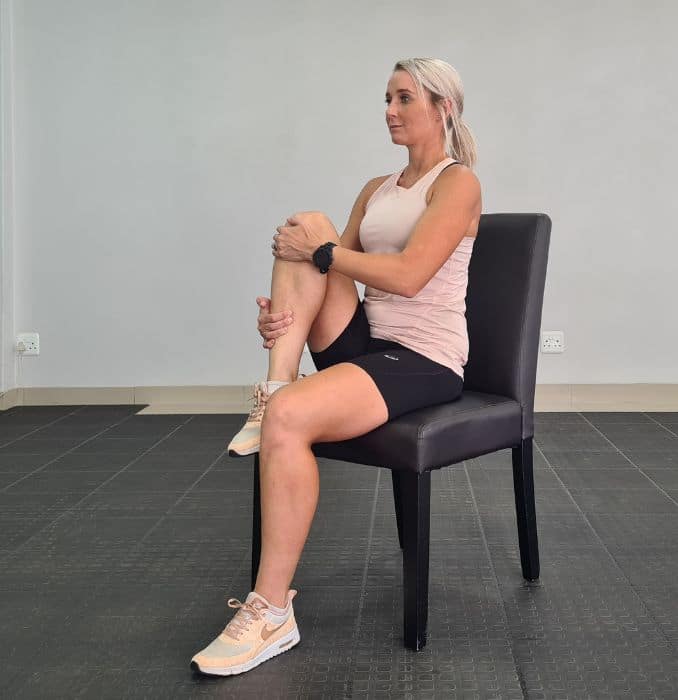 |
Single Knee to Chest
To intensify the movement, slowly move your bent knee in a circular motion.
4. Seated Lunge
Firstly, begin this exercise on How to Loosen Tight Thigh Muscles in an upright sitting position on the chair with your feet flat on the floor, maintaining good alignment with your head, shoulders, and hips. Secondly, turn your body so that you are sitting on the front of the chair with only one-half of your seat. Thirdly, engage your core. Fourthly, extend your leg back with your toes tucked under your heel, looking for a stretch in the front of the hip. Then, hold this position for a few seconds. Relax and return to the starting position. Lastly, repeat the movement on the opposite side. Start with 1 set of 5 repetitions on each side.
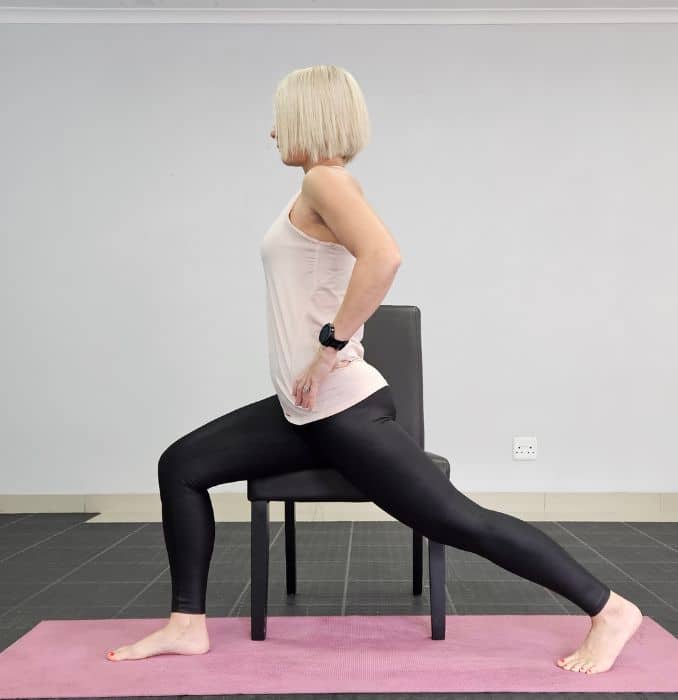 |
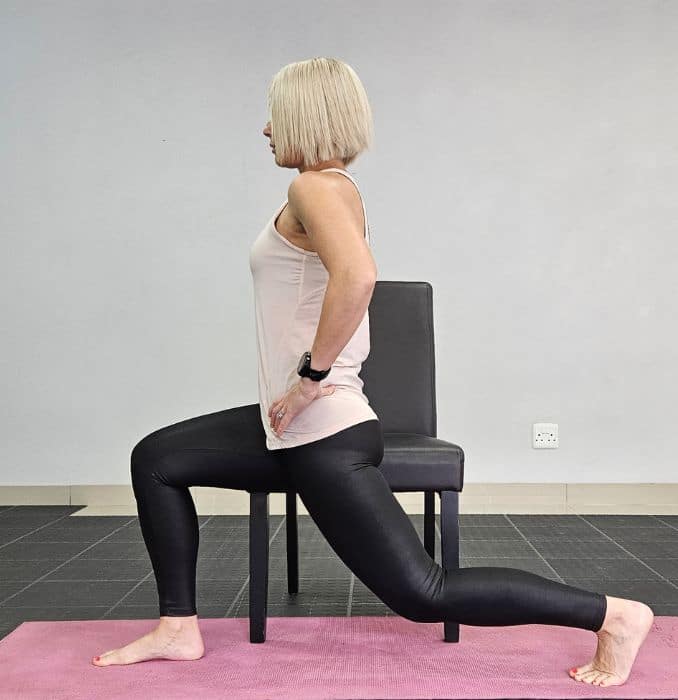 |
Seated Lunge
5. Wide-Legged Forward Fold
Begin in an upright standing position with your feet considerably wider than shoulder-width apart, maintaining good alignment in your upper body. Then, engage your core. Afterward, hinge through your hips to bend your upper body forward, lowering your upper body towards the floor. Drop your hands to the floor or rest them on an elevated surface. Hold this position for several deep belly breaths, in through your nose and out through your mouth. Finally, relax and raise back up to return to the starting position.
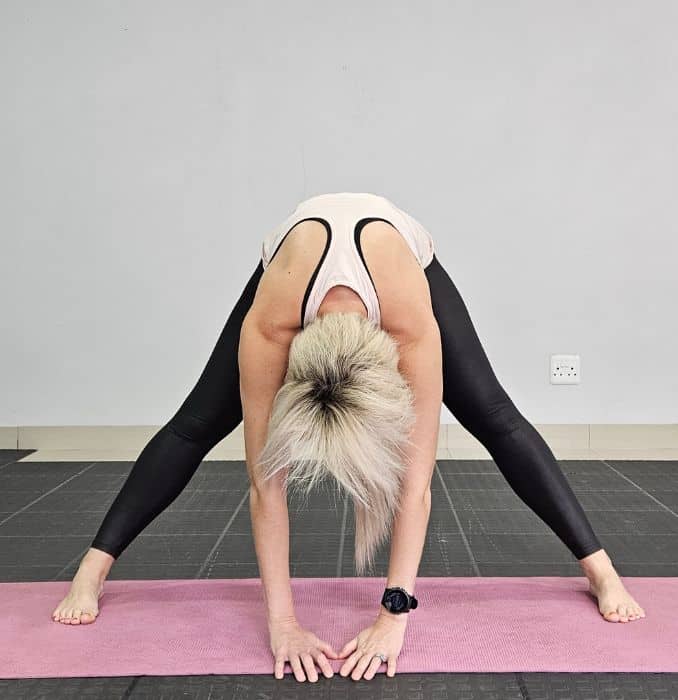
Wide Legged Forward Fold
Depending on your comfort level, lower your head further down and allow your body to feel heavy, bringing your gaze towards the back. Hold this position for a couple of deep belly breaths, in through your nose and out through your mouth.
Moreover, to make the stretch easier, sit on the chair with your hands on your knees and feet considerably wider than shoulder-width apart. Hinge through your hips to move your upper body forward and hold the position for a couple of deep belly breaths.
6. Wide-Legged Side Lunge
Begin in an upright standing position with your feet considerably wider than shoulder-width apart, maintaining good alignment in your upper body. Then, place your hands on your thighs. Afterward, contract your abdominal muscles and shift your body weight to one side while extending your opposite leg. Lastly, return to the starting position and repeat the movement on the opposite side.
 |
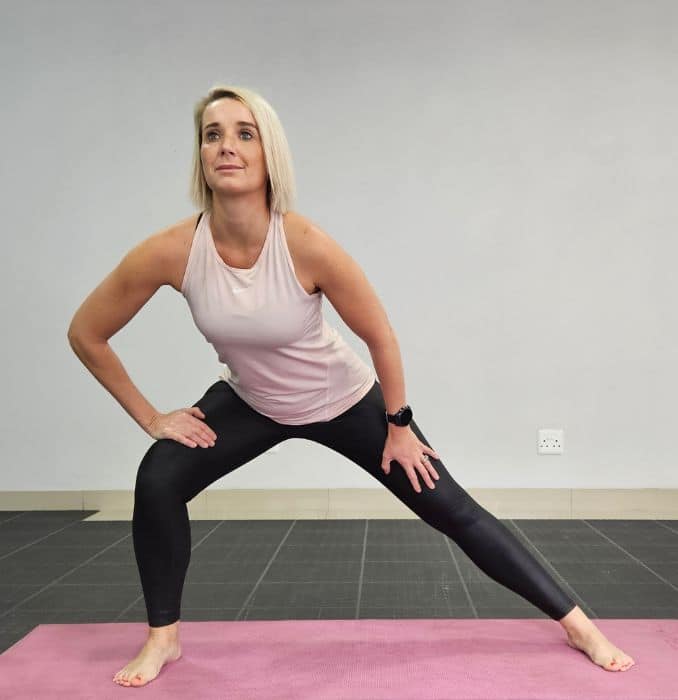 |
Wide-Legged Side Lunge
To make the movement easier, perform the exercise on a chair.
7. Side Lunge Forward Fold
From the Wide-Legged Side Lunge position, hinge through your hips bend your upper body forward, resting your hands on the floor. Engage your core and shift your body weight to one side while extending your opposite leg. Return to the starting position and repeat the movement on the opposite side. Repeat for several repetitions.
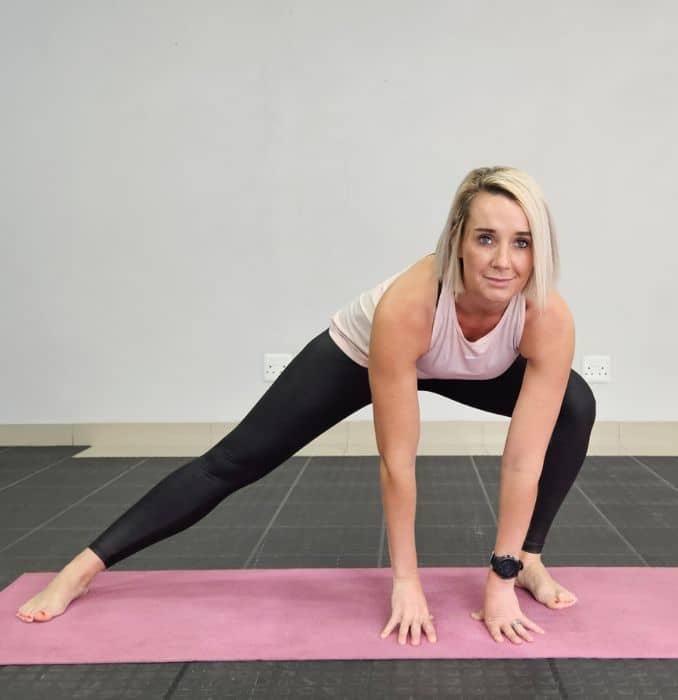 |
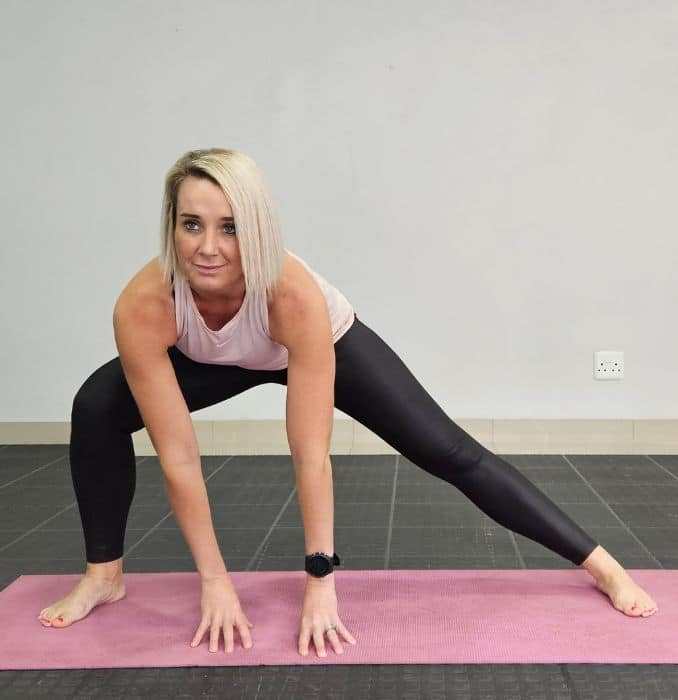 |
Side Lunge Forward Fold
When performing standing lunges, focus on the thigh region by slowly bending it as you step forward with your other leg. When done correctly, this gentle stretch can help loosen tight muscles and connective tissue.
You can also try workouts that involves keeping one leg straight while working on the front leg to target specific muscle groups. These exercises target the quads, hamstrings, and glutes.
8. Low Squat
For this exercise, use a blanket for support if needed.
Begin in an upright sitting position on the edge of the chair with your feet considerably wider than hip–width apart, maintaining good alignment with your head, shoulders, and hips. Place your hands on your inner thighs and tighten your abdominal muscles. Hinge through your hips to move off the chair into a low squat position.
Depending on your comfort level, progress the movement by moving off the chair and slowly lowering your seat towards the floor or blanket for support if needed. Bring your palms together in a prayer position at chest height, pressing your elbows between your knees. Sit as deeply as you are able while evenly distributing your weight across both heels. Relax and raise back up to an upright standing position, squeezing your glutes at the top position.
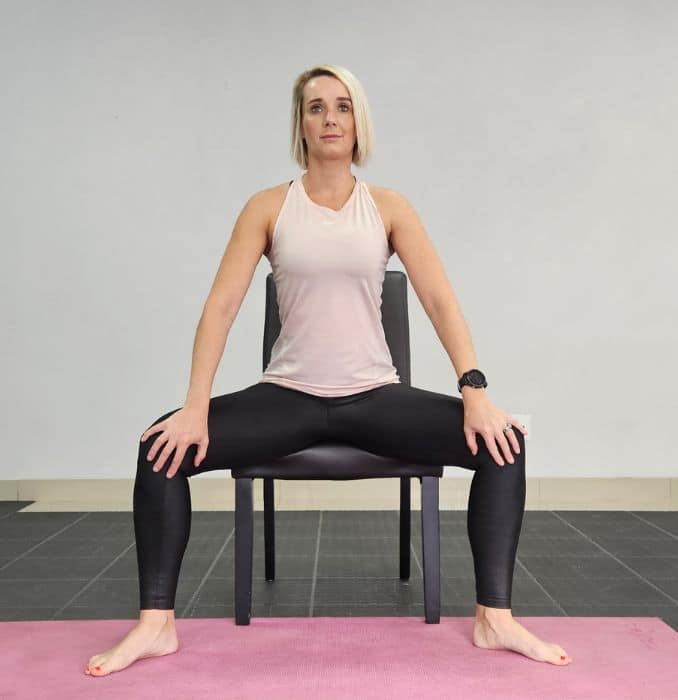 |
 |
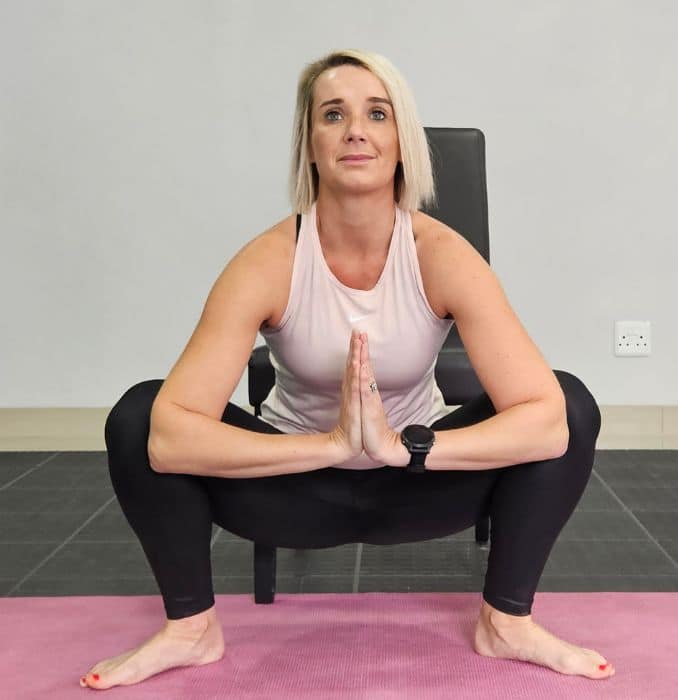 |
Low Squat
9. Supported Chair Pose
Firstly, begin in an upright standing position behind the chair with your feet shoulder-width apart, maintaining good alignment with your head, shoulders, hips, and legs. Secondly, engage your core. Thirdly, place your hands on the back of the chair for support and bend through your hips and knees to move into a low squat position, similar to sitting in a chair. Fourthly, hold the position for several deep belly breaths in through your nose and out through your mouth. Lastly, relax and return to an upright standing position.
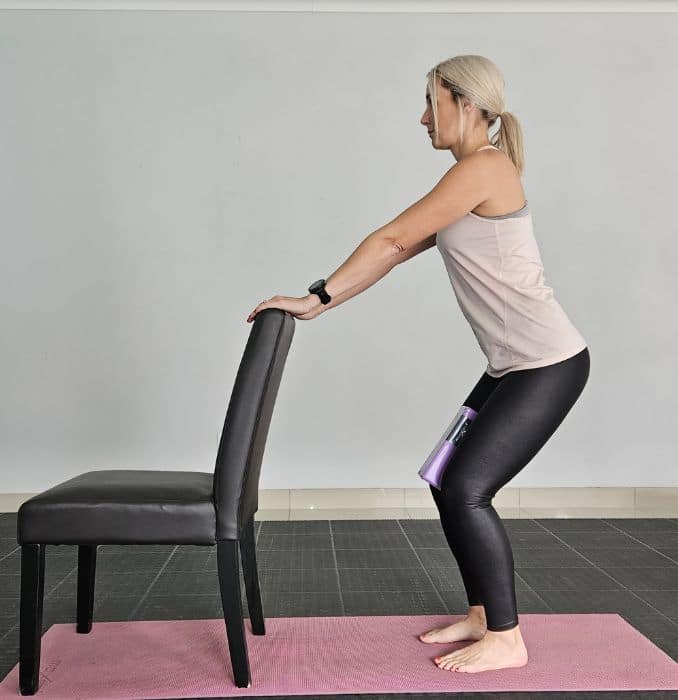
Supported Chair Pose
Depending on your balance and comfort level, perform this movement as a bodyweight exercise.
10. Quad Stretch
Begin in an upright standing position behind the chair with your feet shoulder-width apart, maintaining good alignment with your head, shoulders, hips, and legs. Place your hands on the back of the chair for support and engage your core. Bring one heel up against your seat, holding your foot with your hand. Hold this position for several deep belly breaths, in through your nose and out through your mouth. Repeat the movement on the opposite side.
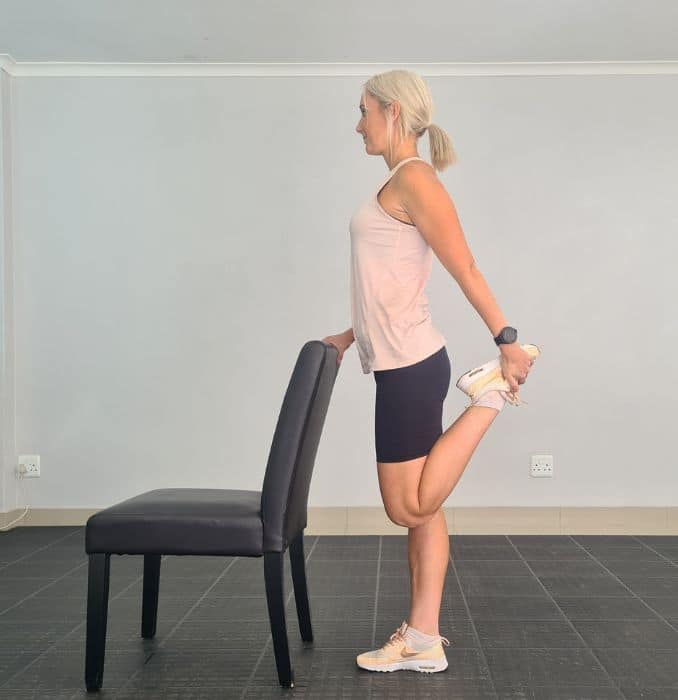
Quad Stretch
To make the stretch easier, perform the movement while seated on the chair.
Thigh Muscle Workouts And Techniques You Can Add to Your Routine
Thighs’ stretch can bring immense relief and improve your mobility. Sit comfortably on a chair with your knees bent and feet flat on the floor, ensuring proper alignment in your upper body. Extend your left leg and point your toes upward.
Engage your core and slowly bend your upper body forward, maintaining a straight back as you reach for your toes with one hand. You'll feel a gentle stretch along the outer thigh of your left leg, targeting your tight muscle and knee joint. Hold the stretch for a few deep belly breaths. Slowly return to the starting position, and if needed, repeat the stretch a couple of times.
Always listen to your body and consult a physical therapist for personalized guidance if your tight thighs persist.
-
Standing Hamstring Stretch
The Standing Hamstring Stretch is an effective exercise to target and alleviate tightness in the hamstring muscles, which run along the back of your thigh. When the hamstrings are stressed, they can contribute to discomfort and limited leg mobility.
You can begin by resting your right leg on the chair, flexing your heel, and ensuring not to bend your right knee. Hold the position for a few breaths.
-
Supine Hamstring stretch
The Supine Hamstring Stretch is an effective technique for targeting and relieving tension in the hamstring muscles. Unlike the Standing Hamstring Stretch, it offers the advantage of being performed while lying on your back, providing stability and comfort. This prone position minimizes the risk of straining the lower back, making it suitable for individuals with balance issues or those new to stretching.
By isolating the hamstrings, this stretch allows for a precise and controlled release of tension, making it a safe option for those recovering from hamstring injuries or looking to enhance flexibility.
Incorporating the Supine Hamstring Stretch into your routine offers a valuable variation in hamstring stretching exercises, promoting overall muscle health and flexibility when performed with proper form and caution against overstretching.
Begin in a seated position, and make sure your legs are straight. Then, bring your left leg to stretch it out to the side gently. This hip flexor stretch targets not only your hip flexors but also your inner thighs.
Start by focusing on your hip flexors and adductor muscles, the key players in your thigh and leg mobility. Gentle stretching exercises can do wonders here.
If you've been experiencing discomfort in your legs, particularly in your thighs, you might be dealing with tight muscles. Tight leg muscles, especially in the thigh area, can often lead to soreness and even pain. But don't worry. There are ways to help alleviate this discomfort and regain leg flexibility.
Similarly, you can stretch your right leg to the side to work on your right hip flexor and inner thigh.
Don't forget about the outer thigh and calf muscles as well. Sometimes, tightness in these areas can contribute to thigh pain. Incorporate stretches that address these muscle groups even at your desk while working or into your routine.
-
Alternate Between Heat And Ice
Using cold and hot treatments are effective ways to relieve the soreness of muscles. Heat helps to relax the muscles and increases blood flow, a great way to reduce pain.
-
Foam Rollers
Foam rollers help loosen tight thigh muscles by applying pressure to the muscle and fascia, breaking up adhesions, increasing blood flow, and promoting relaxation. When rolled along the thighs, they stretch and lengthen muscle fibers, reducing tension and stimulating sensory receptors for a relaxation response.
-
Do Active Recovery Workouts
Active recovery training exercises, including running or swimming, are incredibly beneficial to loosen tight legs and improve strength after hard exercises.
Conclusion
When it comes to non-weight bearing and bodyweight exercises for your thighs, it's important to pay attention to various muscle groups: quadriceps (rectus femoris, vastus medialis, vastus intermedius, and vastus lateralis), hamstrings (semitendinosus, semimembranosus, and biceps femoris), and adductors (gracilis, pectineus, adductor longus, adductor brevis, adductor magnus, and adductor minimus) to promote muscle recovery, improve poor posture, or prevent sports injuries.
Embracing how to loosen tight thigh muscles and a routine of thigh-stretching and strengthening exercises, both bodyweight and non-weight-bearing, can be a truly transformative journey. Your commitment to these exercises is a testament to your dedication to a healthier, stronger you, and for that, you should be immensely proud.
Improving Your Flexibility Can Also Help You Lose Weight, Reduce Back And Joint Pain, And Increase Your Energy. Check out our Flexibility Over 40 Handbook now!

